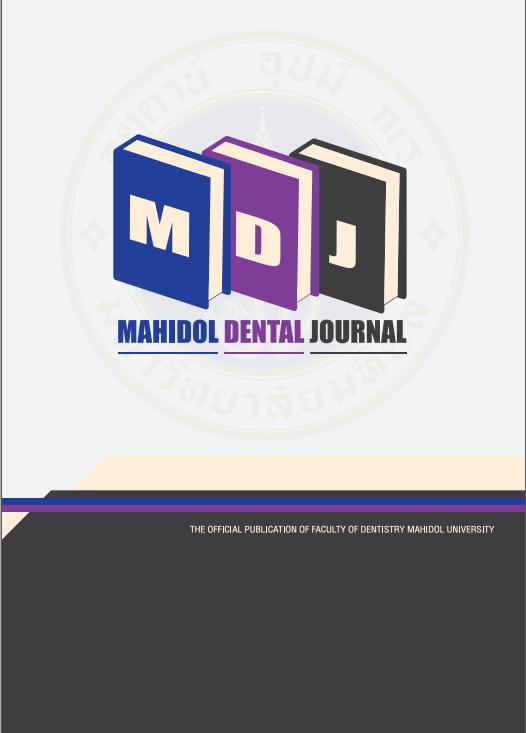Effect of cervical lesions on the rate of survival without fracture in endodontically treated premolars with exposed proximal cavity and restored with resin composite
Main Article Content
Abstract
Objectives: This retrospective study aimed to investigate the effect of an additional cervical lesion on the rate of survival without fracture in endodontically treated teeth (ETT) with exposed occluso-proximal cavity and restored with direct resin composite, and to identify the predisposing factors of fracture.
Materials and Methods: Clinical and radiographic records of patients who received endodontic treatment and direct resin composite restoration in premolars during 2011-2020 were reviewed. Data regarding premolar ETT with exposed occluso-proximal cavity- with (CII+V) and without (CII) the cervical lesion, were analyzed. Incidences of postoperative fracture were identified and categorized into ‘restorable’ or ‘non-restorable’. Cumulative survival rates of CII and CII+V were compared using Kaplan-Meier survival analysis and log-rank test (p-value = 0.05). Cox proportional hazard model was used to identify any potential risk factors for fracture.
Results: In the 102 premolar ETT analyzed from 89 patients, 53 and 49 teeth were CII and CII+V, respectively. With a recall period of 30.7±16.4 months, no significant difference in the cumulative survival rate without fracture between CII (49/53, 92.5%) and CII+V (44/49, 89.8%). For the fractured ETT, a higher incidence of non-restorable and crown-root fracture was reported in CII+V. No predisposing factor for fracture was identified.
Conclusions: The presence of restored cervical lesion did not affect the rate of survival without fracture in premolar ETT with exposed occluso-proximal cavity and restored with resin composite.
Article Details
References
Reeh ES, Messer HH, Douglas WH. Reduction in tooth stiffness as a result of endodontic and restorative procedures. J Endod 1989; 15: 512–16.
Borén DL, Jonasson P, Kvist T. Long-term survival of endodontically treated teeth at a public dental specialist clinic. J Endod 2015; 41: 176–81.
Sorensen JA, Martinoff JT. Intracoronal reinforcement and coronal coverage: a study of endodontically treated teeth. J Prosthet Dent 1984; 51: 780–4.
Baba NZ, Goodacre CJ. Restoration of endodontically treated teeth: contemporary concepts and future perspectives. Endod Topics 2014; 31: 68–83.
Faria ACL, Rodrigues RCS, de Almeida Antunes RP, de Mattos MdGC, Ribeiro RF. Endodontically treated teeth: characteristics and considerations to restore them. J Prosthodont Res 2011; 55:69–74.
Mannocci F, Bertelli E, Sherriff M, Watson TF, Ford TP. Three-year clinical comparison of survival of endodontically treated teeth restored with either full cast coverage or with direct composite restoration. J Prosthet Dent 2002; 88: 297–301.
Suksaphar W, Banomyong D, Jirathanyanatt T, Ngoenwiwatkul Y. Survival Rates from Fracture of Endodontically Treated Premolars Restored with Full-coverage Crowns or Direct Resin Composite Restorations: A Retrospective Study. J Endod 2018; 44: 233–8.
Borcic J, Anic I, Urek M, Ferreri S. The prevalence of non‐carious cervical lesions in permanent dentition. J Oral Rehabil 2004; 31: 117–23.
Zeola L, Pereira F, Machado A, Reis B, Kaidonis J, Xie Z, et al. Effects of non‐carious cervical lesion size, occlusal loading and restoration on biomechanical behaviour of premolar teeth. Aust Endod J 2016; 61: 408–17.
Fei X, Wang Z, Zhong W, Li Y, MIAO Y, Zhang L, et al. Fracture resistance and stress distribution of repairing endodontically treated maxillary first premolars with severe non-carious cervical lesions. Dent Mater J 2018; 37: 789–97.
Kaushik M, Kumar U, Sharma R, Mehra N, Rathi A. Stress distribution in endodontically treated abfracted mandibular premolar restored with different cements and crowns: A three-dimensional finite element analysis. J Conserv Dent 2018; 21: 557-61.
Machado A, Soares C, Reis B, Bicalho A, Raposo L, Soares P. Stress-strain analysis of premolars with non-carious cervical lesions: Influence of restorative material, loading direction and mechanical fatigue. Oper Dent 2017; 42: 253–65.
Pereira FA, Zeola LF, de Almeida Milito G, Reis BR, Pereira RD, Soares PV. Restorative material and loading type influence on the biomechanical behavior of wedge shaped cervical lesions. Clin Oral Invest 2016; 20: 433–41.
Tay F, Pashley D. Monoblocks in root canals: a hypothetical or a tangible goal. J Endod. 2007;33 :391-98.
Ferrari M, Vichi A, Fadda G, Cagidiaco M, Tay F, Breschi L, et al. A randomized controlled trial of endodontically treated and restored premolars. J Dent Res 2012; 91: S72–8.
Dammaschke T, Nykiel K, Sagheri D, Schäfer E. Influence of coronal restorations on the fracture resistance of root canal‐treated premolar and molar teeth: A retrospective study. Aust Endod J 2013; 39: 48–56.
Nagasiri R, Chitmongkolsuk S. Long-term survival of endodontically treated molars without crown coverage: a retrospective cohort study. J Prosthet Dent 2005; 93: 164–70.
Caplan D, Kolker J, Rivera E, Walton R. Relationship between number of proximal contacts and survival of root canal treated teeth. Int Endod J 2002; 35: 193–99.
Aquilino SA, Caplan DJ. Relationship between crown placement and the survival of endodontically treated teeth. J Prosthet Dent 2002; 87: 256–63.
Dietschi D, Bouillaguet S, Sadan A. Restoration of the endodontically treated tooth. In: Hargreaves KM, Berman LH, editors. Cohen’s Pathway of the Pulp. 11th ed. Canada: Elsevier; 2016, p. 818–48.


